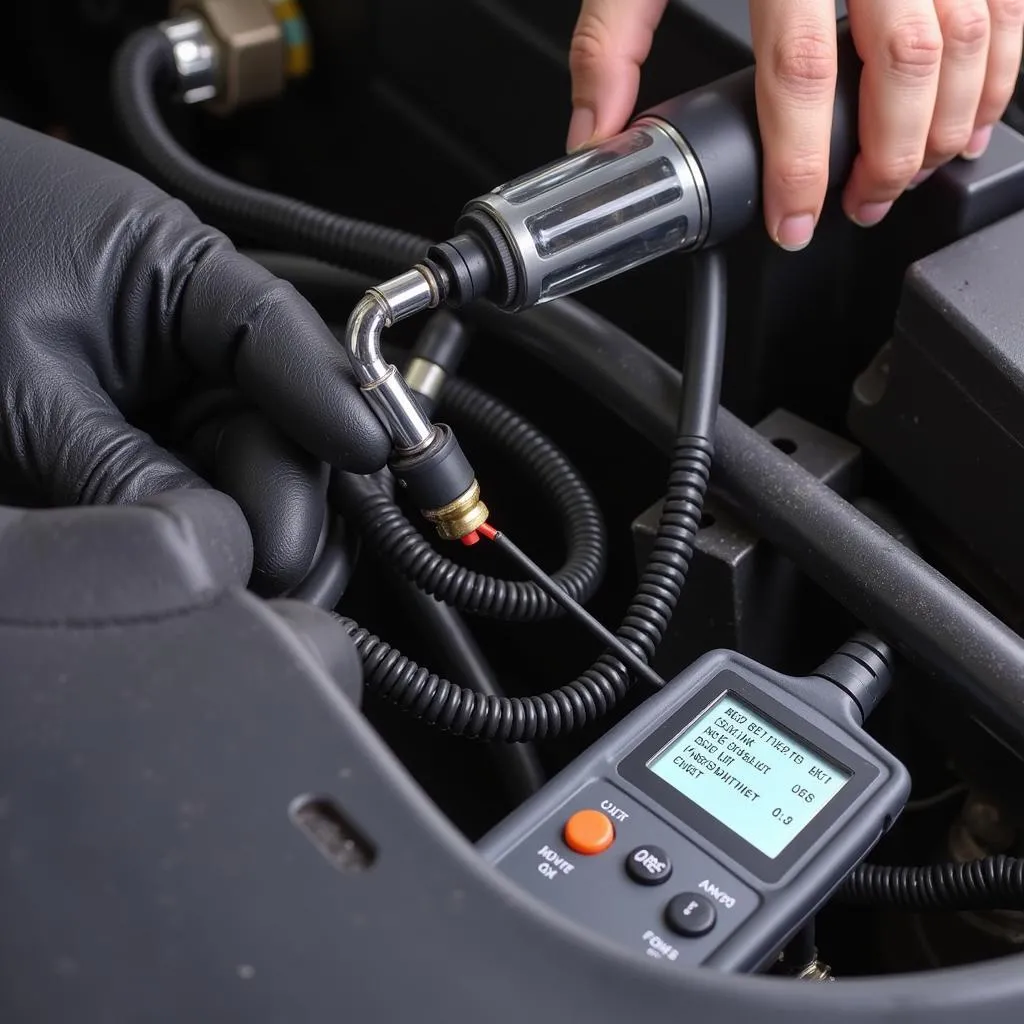Bleeding your Ford’s ABS system might sound intimidating, but with the right scan tool, it’s a manageable task for the DIY mechanic. This guide will walk you through the process, explaining how a scan tool can make bleeding your Ford ABS system a breeze.
Why Bleeding Your Ford ABS System Matters
Your Ford’s Anti-lock Braking System (ABS) is crucial for safe driving. It prevents wheel lock-up during hard braking, ensuring you maintain steering control. Over time, air can infiltrate the ABS system, compromising its performance. Bleeding the system removes this trapped air, restoring optimal braking and safety.
When a Scan Tool is Essential for Bleeding Your Ford ABS
While some older Ford models allow for traditional bleeding methods, many newer vehicles require a scan tool to cycle the ABS module and release trapped air effectively. This is because modern ABS systems are more complex and electronically controlled.
Here’s why a scan tool is crucial for bleeding your Ford ABS system:
- Activate ABS Module: A scan tool can activate the ABS module, opening and closing solenoids to release air pockets trapped within.
- Enhanced Bleeding Efficiency: Using a scan tool alongside traditional bleeding techniques ensures a thorough air purge, maximizing braking performance.
- Diagnose ABS Issues: If you’re experiencing ABS problems beyond needing a bleed, a scan tool can help diagnose the issue by reading and clearing fault codes.
 Ford ABS Module
Ford ABS Module
Choosing the Right Scan Tool for the Job
Not all scan tools are created equal. For bleeding your Ford’s ABS system, you’ll need one with specific capabilities:
- ABS Bleeding Function: Ensure the scan tool explicitly states its compatibility with Ford ABS bleeding procedures.
- Ford Compatibility: The scan tool must be compatible with the make, model, and year of your Ford vehicle.
- User-Friendliness: Opt for a scan tool with a clear interface and intuitive software for ease of use.
 Scan Tool Bleeding Ford ABS
Scan Tool Bleeding Ford ABS
Bleeding Your Ford ABS System: A Step-by-Step Guide
Before you begin, gather these essential items:
- Compatible scan tool
- Brake fluid (DOT 3 or DOT 4, as recommended by your Ford owner’s manual)
- Clear tubing
- Wrench set
- Catch bottle
- Assistant
Now, let’s get started:
- Safety First: Park your Ford on a level surface, engage the parking brake, and disconnect the negative battery cable.
- Connect Scan Tool: Plug the scan tool into your Ford’s OBD-II port, typically located under the dashboard on the driver’s side.
- Enter ABS Bleeding Mode: Power on the scan tool and navigate to the ABS bleeding function. Follow the on-screen prompts to initiate the process.
- Prepare for Bleeding: Locate the bleeder valve on the ABS module or the wheel cylinder furthest from the master cylinder. Attach the clear tubing to the bleeder valve and submerge the other end in the catch bottle containing a small amount of brake fluid.
- Bleeding Process: Have your assistant slowly depress the brake pedal while you loosen the bleeder valve to allow air and old fluid to escape. Tighten the valve before your assistant releases the brake pedal. Repeat this process until you see clear, air-free fluid flowing through the tubing.
- Follow Scan Tool Instructions: The scan tool will guide you through specific steps, such as cycling the ABS pump or moving to different bleeder valves. Follow these instructions meticulously for a successful bleed.
- Complete the Process: Once the scan tool indicates the bleeding process is complete, double-check the brake fluid level in the master cylinder reservoir and top it off as needed.
- Test Your Brakes: Reconnect the negative battery cable and take your Ford for a cautious test drive to ensure the brakes are functioning correctly.
Pro Tip: Bleeding your Ford’s ABS system can be messy. Wear gloves and eye protection to avoid contact with brake fluid.
BMW Diagnostic Scan Tool iCarsoft BM II
 Bleeding Ford ABS System
Bleeding Ford ABS System
Common Ford ABS Bleeding Issues and Solutions
Even with a scan tool, you might encounter some hiccups during the bleeding process. Here are some common issues and how to resolve them:
- Stubborn Air Pockets: If air persists in the system, try tapping lightly on the ABS module or brake lines with a rubber mallet while bleeding to dislodge trapped air bubbles.
- Scan Tool Communication Errors: Ensure the scan tool is properly connected to the OBD-II port and that it’s compatible with your Ford model. Updating the scan tool’s software can also resolve communication issues.
- Spongy Brake Pedal: A spongy brake pedal after bleeding usually indicates air remains in the system. Repeat the bleeding process carefully, ensuring you follow the scan tool’s instructions precisely.
When to Seek Professional Help
While bleeding your Ford ABS system with a scan tool can be a DIY project, certain situations warrant professional assistance:
- Persistent ABS Issues: If you’ve tried bleeding the system multiple times and are still experiencing ABS problems, it’s best to consult a qualified mechanic.
- Lack of Experience: If you’re uncomfortable working with brake systems or using a scan tool, it’s safer to have a professional handle the bleeding process.
Scan Tool for Bleeding ABS Brakes
Conclusion
Bleeding your Ford ABS system is essential for maintaining optimal braking performance and ensuring your safety on the road. While traditional methods might suffice for some older models, utilizing a scan tool is often necessary for effectively bleeding modern Ford ABS systems. By following the step-by-step guide and taking necessary precautions, you can bleed your Ford ABS system with a scan tool and enjoy enhanced braking confidence. Remember, if you encounter persistent issues or feel uncomfortable with the process, seeking professional help is always the safest option.


